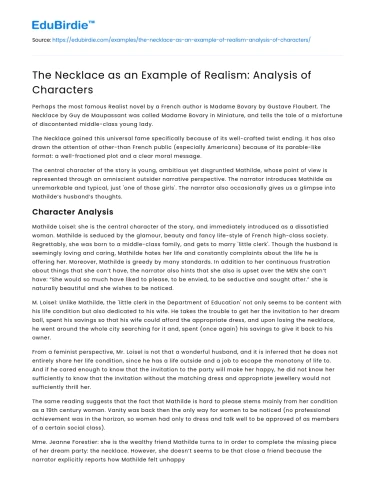Perhaps the most famous Realist novel by a French author is Madame Bovary by Gustave Flaubert. The Necklace by Guy de Maupassant was called Madame Bovary in Miniature, and tells the tale of a misfortune of discontented middle-class young lady.
The Necklace gained this universal fame specifically because of its well-crafted twist ending. It has also drawn the attention of other-than French public (especially Americans) because of its parable-like format: a well-fractioned plot and a clear moral message.
Save your time!
We can take care of your essay
- Proper editing and formatting
- Free revision, title page, and bibliography
- Flexible prices and money-back guarantee
The central character of the story is young, ambitious yet disgruntled Mathilde, whose point of view is represented through an omniscient outsider narrative perspective. The narrator introduces Mathilde as unremarkable and typical, just 'one of those girls'. The narrator also occasionally gives us a glimpse into Mathilde’s husband’s thoughts.
Character Analysis
Mathilde Loisel: she is the central character of the story, and immediately introduced as a dissatisfied woman. Mathilde is seduced by the glamour, beauty and fancy life-style of French high-class society. Regrettably, she was born to a middle-class family, and gets to marry 'little clerk'. Though the husband is seemingly loving and caring, Mathilde hates her life and constantly complaints about the life he is offering her. Moreover, Mathilde is greedy by many standards. In addition to her continuous frustration about things that she can’t have, the narrator also hints that she also is upset over the MEN she can’t have: “She would so much have liked to please, to be envied, to be seductive and sought after.” she is naturally beautiful and she wishes to be noticed.
M. Loisel: Unlike Mathilde, the 'little clerk in the Department of Education' not only seems to be content with his life condition but also dedicated to his wife. He takes the trouble to get her the invitation to her dream ball, spent his savings so that his wife could afford the appropriate dress, and upon losing the necklace, he went around the whole city searching for it and, spent (once again) his savings to give it back to his owner.
From a feminist perspective, Mr. Loisel is not that a wonderful husband, and it is inferred that he does not entirely share her life condition, since he has a life outside and a job to escape the monotony of life to. And if he cared enough to know that the invitation to the party will make her happy, he did not know her sufficiently to know that the invitation without the matching dress and appropriate jewellery would not sufficiently thrill her.
The same reading suggests that the fact that Mathilde is hard to please stems mainly from her condition as a 19th century woman. Vanity was back then the only way for women to be noticed (no professional achievement was in the horizon, so women had only to dress and talk well to be approved of as members of a certain social class).
Mme. Jeanne Forestier: she is the wealthy friend Mathilde turns to in order to complete the missing piece of her dream party: the necklace. However, she doesn’t seems to be that close a friend because the narrator explicitly reports how Mathilde felt unhappy to witness the life Mme. Forestier was leading. Moreover, after Mathilde returned the diamond necklace, she did not meet her again until 10 years later. Which means that she was ashamed to let Jeanne see how poor she became.
Analysis of the Setting
Very few details are evoked about the setting of the story, but what is certain is that the events take place in Paris, around the 19th century.
This period is commonly known as la 'Belle Époque”, mostly famous for the glamourous and fashionable way of life. Something which perfectly makes a case for Mathilde’s feeling of alienation and incompletion.
Writing Style
Maupassant is known for his effortless economical writing, and his incredible ability to manipulate the pace through which the events evolve. The Necklace is characterized by its predominant short paragraphs (sometime a little over two or three sentences) which only report the essential events and needed descriptions; this choice is what allows the fluidity of the events and the “short” aspect of the story.
As to longer paragraphs, Maupassant's got another noteworthy technique, which is repeating the same words (pronouns, for the most part) at the beginning of sentences. This repetition adds an elegant simplicity to the writing, and increases the orderly aspect of the narrative.
interesting, and bring a sense of closure to the paragraph. And all the repetition just feels
The characters are described using a combination of detached and compassionate tones all at once: he closely reports the very thoughts of the central character, Mathilde, and invites the reader to her inside world, but without completely exposing her emotions.
Conclusion
Though contextually and historically a very pertinent portrayal of the overall 19th century women condition, Guy de Maupassant’s Necklace is timeless and could perfectly correspond to many common issues of the current times. Greed, dissatisfaction, pride and the problems of appearances can engender numerous personality and relational problems. And the piece of jewellery itself is used an item to symbolize that things only bear the value people attribute to them.






 Stuck on your essay?
Stuck on your essay?

